Posted by LinkedSelling in B2B Lead Generation & Sales Development

Selling isn’t easy.
Even for the “naturals”.
It takes preparation and let’s face it, gumption.
Will Smith in “The Pursuit of Happiness” takes a job cold calling people off a list. He finds ways to speed up the process so he can call more people a day… one of his tactics is to not hang up the phone, instead simply hitting the dial button between calls. And yet, for all his time saved, he really didn’t get anywhere with the people he was trying to call.
They didn’t know him. They knew they were on a list. They had no trust that he had their best interests.
What Will Smith’s character did have results with though was basically cornering a man at the stock brokerage he wanted to work for and developing a relationship with him. While we don’t recommend cornering people, in his case, it worked out…
What was a cold lead became a warm lead who he was able to close precisely because they were able to build a relationship. Will Smith’s character provided value every step of the way and stayed persistent in following up.
The moral of this story isn’t to promote a movie. It’s to get you thinking about the approaches he uses - and when they’re most useful.
As an outbound lead generation company looking at the selling processes in our own sales department and in talking to our clients about their sales processes, we’ve discovered that one of the hardest things about selling is knowing when to adapt your sales approach based on what kind of prospect you’re talking to and where they’re at in the buying process.
In this blog post, we’re looking specifically at the differences in selling to cold leads vs warm leads.
It's essential that cold and warm prospects be treated differently. When you understand that it will take a little longer to get someone who is completely cold to purchase or be interested in a company's product you can adapt your strategy and see greater success.
For example, someone coming in cold should not be expected to sell as easily as a referral or someone who already sought you out (warm leads). There needs to be a nurturing and credibility-building process and a "dating" period before asking for the "wedding".
Thrive Leads Shortcode could not be rendered, please check it in Thrive Leads Section!
How to Sell Based On the Type of Prospect You’re Working With
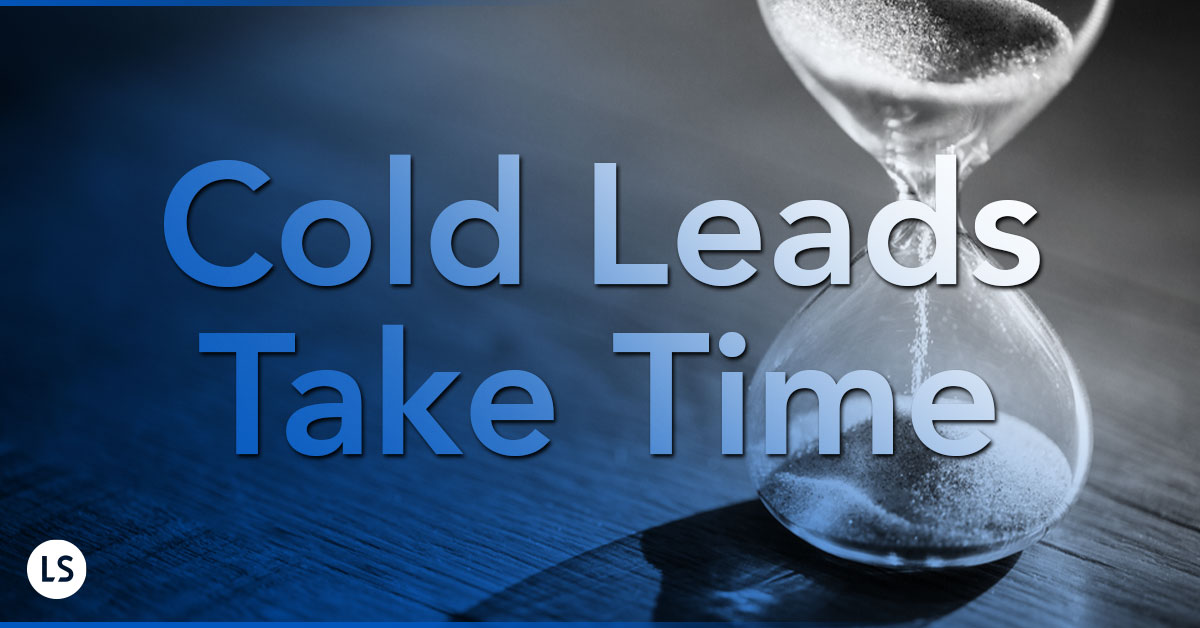
First of all, it’s important to note that it’s so much easier to sell when somebody’s been around, who’s been on your list for a while. Cold leads take time to warm up to us, sometimes a lot of time before you can even have a sales conversation. We’ve asked some of our clients how long they’ve known about us before they decided to work with us, and putting aside those who came to us ready to buy, some had come to us initially as cold leads and had been on our list and had been receiving content for a long time - in some case a year or more.
Keeping that in mind, at LinkedSelling, what we do internally and on behalf of our clients when approaching cold leads, is that we approach cold prospects by first offering them something that addresses a pain point that they may have, such as a lead magnet download, webinar, case study, etc.
Then there is a “warm up period” where that prospect is nurtured through additional messages and emails to build awareness and credibility. These are now considered “warm leads”. Light calls to action are included in these various pieces of outreach and we attempt to move prospects from “cold” to “warm” to becoming a buyer.
Understanding this process will save you both time and costly mistakes. For example, most people expect a new, cold prospect who just came in off an ad campaign or who is just within the first couple of touchpoints to sell and be ready to buy right off the bat.
Even when a company tells us that their normal sales cycle lasts 3-6 months, they start an outreach or ad campaign with us and still expect to have a new sale (or say, 5) one month into the campaign.
If their sales process is generally 3-6 months for REFERRALS or WARM traffic from their website, then why would a business expect to have COLD sales a month or two into the campaign? It happens all the time. Our campaigns are all built to move a prospect from cold to warm and then to becoming a Sales Qualified Lead, but it takes a little time.
Remember, you don't just start dating someone and ask them to marry you in the first month. And you should always expect any cold leads that come through one of our campaigns to take either just as long or longer than your regular average sales cycle.
Thrive Leads Shortcode could not be rendered, please check it in Thrive Leads Section!
What Are Cold Leads?
A cold lead is a potential prospect who you’ve reached out to with the intent to sell even though they may have no knowledge - or need - of you, your company, or your product or service.
In fact, it could be a prospect that fits the prospect profile, but they have little to no knowledge about the selling company. They may have just entered a funnel or showed interest in something that the seller company has, but they are not aware enough or have not taken further action to buy.
We’ve all been on the receiving end of a cold call. Maybe it’s the credit company who’s calling out of the blue in hopes of getting you to sign up for one of their credit cards. Maybe it’s insurance. Maybe it’s a marketing agency who’s called someone on your team to offer advertising services.
No matter what they’re offering, what they all have in common is this: their call wasn’t expected and it was frankly annoying and disruptive to your work day (not in a good way!).
How To Sell to Cold Leads
Let’s start with what NOT to do with a cold lead. You might recognize a call like this…
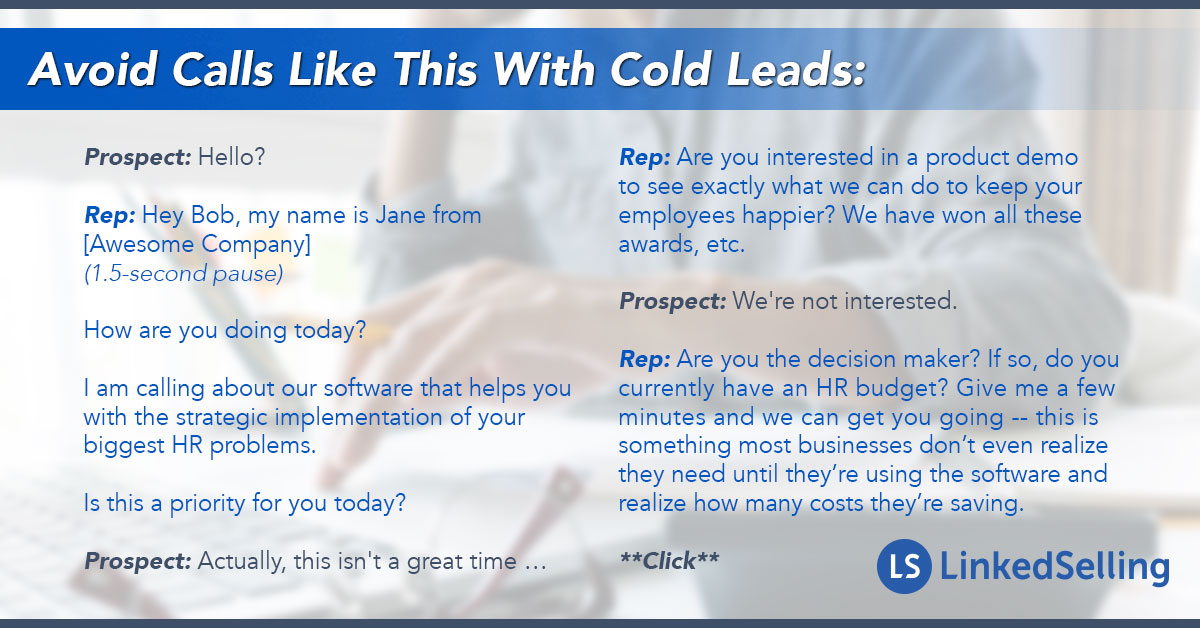
Does this sound familiar? It also happens on LinkedIn or via email. I’m sure you recognize the same type of conversation when someone immediately pushes their agenda on you - whether or not you’re qualified or interested.
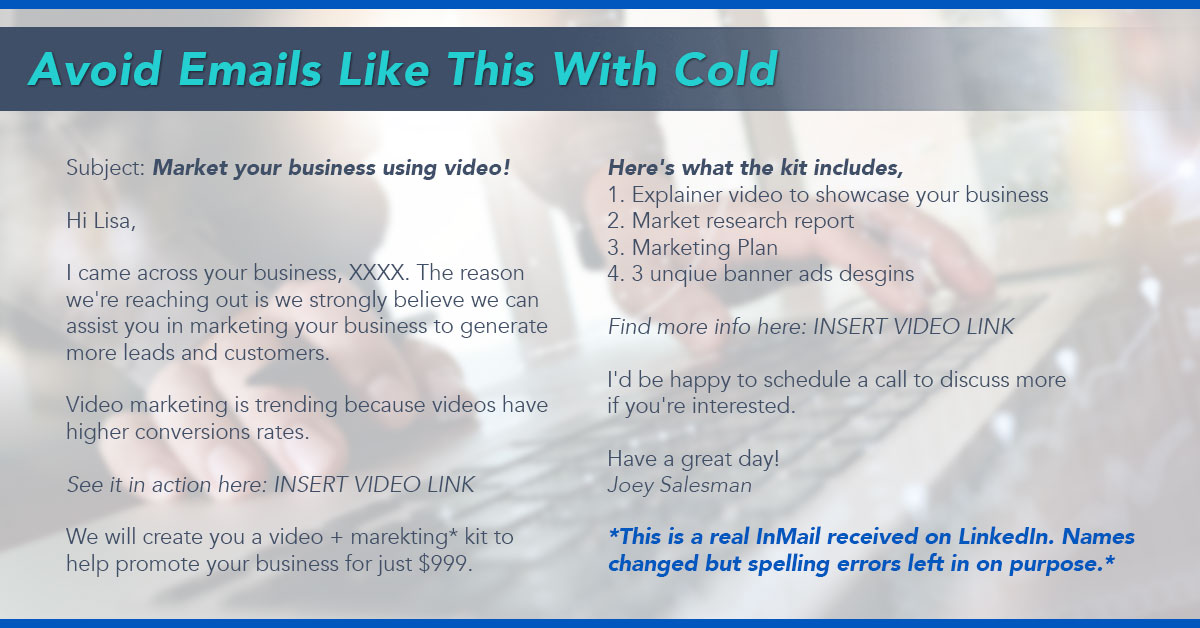
What’s the problem with these examples? Besides the spelling errors, they’re pushy and downright intrusive and annoying. You don’t know anything about them and you’re probably not currently in the market for their services.
One problem for sales teams is that these kinds of touchpoints with cold leads have no qualifying process. This is one reason why salespeople get a bad rap; they’re just trying to push their products or services on you, not find out what you really need, or bother identifying if you’d be a likely candidate interested in their offerings to begin with.
In addition, when it comes to sales methodology, it’s a pure numbers game. As the cold leads have shown no previous interest, and you have no previous relationship with them, the more cold leads you call, the more likely you are to find someone who happens to need what you offer. The hard part about this is that it’s truly a “spray and pray” approach. You have very little control over your results except over how many cold leads you reach out to.
All is not lost though, if you’re interested in beating the numbers game, read more about how to generate sales opportunities at scale.
Thrive Leads Shortcode could not be rendered, please check it in Thrive Leads Section!
Tips for Selling to Cold Leads
The goal here is to develop relationships that open the door to real business conversations. Here are some tips for taking a cold lead and turning opening up the door to real business conversations and sales opportunities.
We also hear all the time that when you make too big of an ask of a prospect before they are ready, that prospect is no longer a prospect and is lost. So instead of going right for the sale immediately, we nurture them a bit and then drive them to a discovery call to learn more and see if anything is a fit...all while sharing more credibility, testimonial, and how to solve their pain points information.
Your sales efforts, especially with cold leads will fail without first building a strong foundation with the right positioning and ensuring that you have the right prospects for your business.
Here are some other tips to consider when you want to turn cold leads into warm leads, and then sales qualified prospects:

- Do your research.
Do not just buy a list and start calling. It’s better to build a targeted database of prospects and find out something about the person you’re about to communicate with first. As far as you can tell, do they fit your basic criteria for a qualified lead? - Focus on understanding them, not on getting them to understand you.
Ding Ding Ding! We have a winner! Too many conversations are about who you are… instead of who they are. This is a big turn off. Instead, learn about what they need and give it to them (add value, see #5 below) - Personalize your communications.
While it’s a time saver to send out a boiler plate message or email, it’s always worth the extra few minutes spent to personalize your communications, especially if you want them to remember you. It can also help knowing that New Epsilon research indicates 80% of consumers are more likely to make a purchase when brands offer personalized experiences. - Ask questions.
To understand you need to get them talking about what they need (ie how you might be able to help - but it should come from them) - Plan those questions ahead of time.
Don’t sound like a robot, but have an idea of the information you need to take the conversation to the next step. - Take time to add value and build a relationship.
This is where a lead turns from cold, to warm, to hot (& qualified). Most cold calls are shut down because they’re intrusive and irrelevant. A relationship allows you to position yourself differently. Add value by sharing relevant and helpful content. This not only helps break the ice, but will help to establish trust. - Be kind and helpful, but be persistent in your follow-up.
With cold leads, your goal is to turn them into warm leads. How long does it take to do that? Well, certainly more than one outreach attempt. There are many reports as to how many touchpoints it takes. We’ve seen reports that suggest at least 5 to more than 21. It depends on your industry, sales cycle, the buyer’s process, and a number of factors. Our rule: keep going until you get a firm YES or NO answer.
What Are Warm Leads?
Warm leads are simply people who’ve expressed interest in you, your company, or one of your product or service offerings. It’s likely they may have an interest, but no sense of urgency or specific timeline to make a buying decision.
The company has likely had some type of communication with them before, even if it's as simple as opting-in for your e-book or report, registering for your webinar, or signing up to receive your monthly newsletter. The point is, they know a little bit about you.
These leads often come into your world through effective marketing strategies. They may not be ready to buy, but they’ve shown an interest and lead to more effective sales conversations. So sometimes, these prospects that have downloaded a report for example, will reach out to your company on their own looking for an appointment. Other times if you have a sales development rep who can call them after they’ve downloaded the report, the call may technically be labeled a “cold call” because your company has never spoken with the lead one on one before, but they are still considered a warm lead because the prospect has shown some interest.
These warm leads may also be from referrals, where the trust for your company in this case is gained thanks to the trust that the referrer has for you. Sometimes in these instances, the warm lead may not even look into your company much, just ways to get in touch with you because someone referred them to you as a solution for their problem.
As you can imagine, these types of leads can be treated very differently from cold leads. Warm leads more readily become qualified prospects that convert to real sales opportunities because you’ve already got some common ground with them.
Thrive Leads Shortcode could not be rendered, please check it in Thrive Leads Section!
How to Sell to Warm Leads
First things first, understand who you’re talking to. At this point the lead is still very much a “lead” - not necessarily a real sales opportunity yet. As part of our sales process at LinkedSelling, we’d still identify them as a “Suspect” - not even a “Prospect” yet. They still need relationship building and nurturing.
As a warm lead however, they already have some level of trust or interest in your company. That could come from the marketing they’ve been exposed to; they’ve seen your content and interacted with the company in some way. Marketing is a good team to help with nurturing at this point, using email campaigns for example.
How To Talk to Your Warm Leads
Let’s take someone, a warm lead who has downloaded a report from your website. This is a prime time to have your sales development rep (your SDR) call them because they’ve shown interest in your content.
Studies have proven that increasing your “Speed to Lead” time results in much higher sales conversions. This has proven to be true for us as well. Instead of waiting a week or more to call a prospect who’s requested our content, we saw an increase of 33% more sales appointments when we simply started calling the prospects within 24 hours of downloading content.
One of the benefits of calling when your prospect is still interested is that you have something relevant to talk about.
To quote the write-up we did on it:
“If you want to book more appointments, timing definitely matters. You want to find the sweet spot of finding a good prospect, with a relevant and urgent problem, and then offer your solution (or at least start the relationship). Again, the key is to do this while they’re engaged with you. Show up right when they need you and not only are you more memorable - you’re helpful. You’re a resource they can get immediate information from.”
This is KEY to selling to warm prospects:
Add value using the right message, through the adequate channel at the right time.
This is why we:
- ...spend so much time on creating a prospect profile and try to understand each of our prospects as much as possible
- ...why we use a multi-channel approach to marketing and sales
- ...and why the “Speed to Lead” time matters.
So back to our prospect who’s downloaded content...
They’re now a warm lead and at a prime time to receive your outreach! Timing here is key! Your SDR can call them up and thank them for downloading the content. They can ask them about it, and use that to lead into other questions, to qualify them and to encourage them to make an appointment with your sales team. The SDR might also be able to help instill a sense of urgency so that warm prospect takes some type of action.
Once on the phone with a sales rep, the prospect at this point is qualified and very engaged. Don’t lose the momentum! Definitely send out emails to remind them of your appointment (and increase your show-up rate) and definitely learn what a good sales call looks like.
We went in depth on that topic here: What A Good Sales Call Looks Like
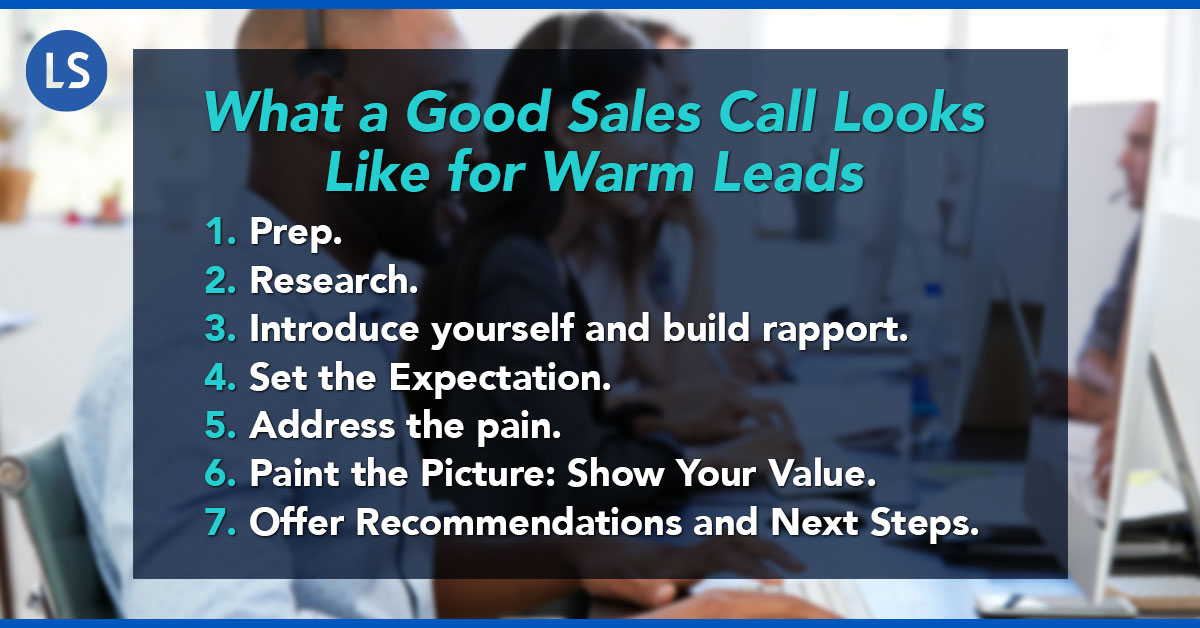
To recap, here are our top tips for selling to warm leads…
Tips for Selling to Warm Leads
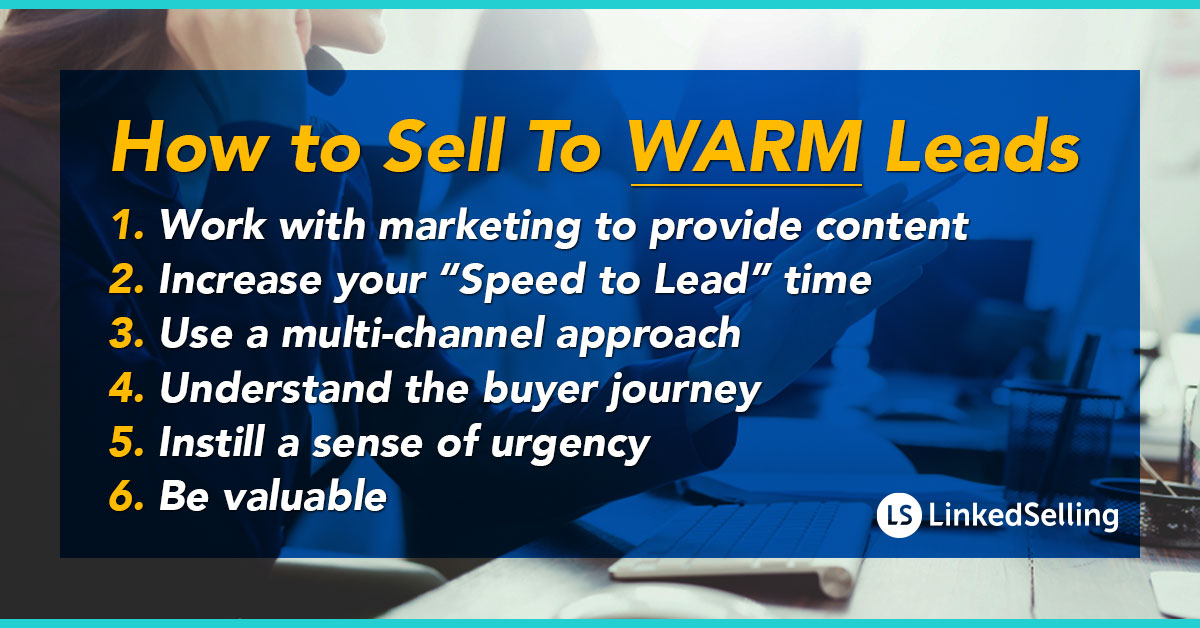
- Work with marketing to provide educational materials and to nurture your warm leads.
- Increase your “Speed to Lead” time and call your warm leads when they are interested.
- Use a multi-channel approach in your lead generation and sales development to connect with your warm leads, find out where they spend their time (and when) and reach out on several different platforms. (This post has more information on that process.)
- Understand the buyer journey and design your sales process around it. Know where your prospects are coming from, how much they know about solutions available (including your solution) and where they are in their decision making process. The important thing here is to meet them where they’re at.
- Instill a sense of urgency by really diving down into their pain points (for example, what will happen if this doesn’t get fixed?), as well as the benefits of solving their pain points (what would happen if you didn’t have the [pain point]? What would that mean for the company?). Finally, offer some other incentive to encourage them to take the next step.
- Be valuable. Continue to provide relevant content but also offer product demos and share client testimonials and case studies. These will go far in helping the warm lead see the utility in your products and services and take the next steps to becoming a sales qualified prospect.
Next Steps
How you choose to pursue a lead can vary depending on your business model and current resources. It’s important to be clear on who you’re speaking with and what kind of sales strategy aligns best with where they’re at in their decision making process. With the right strategy and intention, you can nurture a lead from any stage into qualified sales prospects.
To kick your lead generation and sales development efforts into high gear, consider talking to an expert about your strategy to keep your pipeline full of sales qualified prospects (not just cold or warm leads).
Thrive Leads Shortcode could not be rendered, please check it in Thrive Leads Section!
